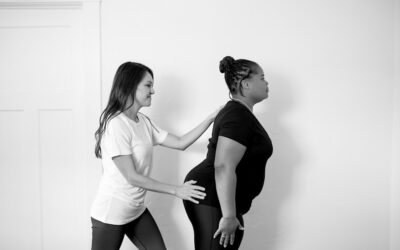Pregnancy, labor, and childbirth are tough on the core and pelvic floor. While birthing people tend to say welcoming their little one is worth the work, many of us would like to avoid the toughest challenges. That leads us to ask some big questions, like how to prevent diastasis recti.
What is diastasis recti?
Diastasis recti is abdominal separation of the rectus abdominis muscles – aka the 6-pack ab muscle. Basically, what happens when the connective tissue in the middle of your abdominal muscles separate.
The rectus abdominis runs vertically from the sternum to the pubic bone. The midline between those ab muscles is the linea alba which is what gets thinner as your belly grows during pregnancy. Hormonal changes and pressure in the abdomen from your growing baby can stretch the linea alba, causing diastasis recti.
This makes it difficult to activate those 6 pack muscles and can also cause symptoms related to pelvic floor dysfunction. These include urinary incontinence, low back pain, and decreased pelvic organ support.
Can diastasis recti be prevented?
Diastasis recti is not 100% preventable, and most birthing people will experience it to one degree or another. You can, however, reduce the risk of severe diastasis recti!
Risk Factors for Diastasis Recti
Diastasis recti is more likely to occur:
- During the second and third trimester of pregnancy and the first 12 months postpartum.
- If you’ve previously had diastasis recti or pelvic floor dysfunction.
- With repetitive straining exercises, like crunches, HIIT classes, or CrossFit.
Although not all pregnant or postpartum women experience diastasis recti, pregnancy is a significant risk factor. That’s especially true if:
- Your pregnancies are close together, especially within 18 months of one another.
- You’re pregnant with multiples, like twins or triplets.
- Your growing baby has a high birth weight
- You have joint hypermobility syndrome.
Genetics also plays a part. If your mom had diastasis recti, you’re more likely to experience it, too. This correlation may be linked to certain inheritable conditions, including connective tissue disorders such as Ehlers-Danlos Syndrome.
If these risk factors ring a bell for you, don’t panic. It just means that, for you, the answer to “how to prevent diastasis recti” is to offer your body a little extra TLC.
How to Prevent Diastasis Recti
#1 Breathe correctly.
Diastasis recti can be both caused and made worse by too much or inappropriately managed intra-abdominal pressure. This often happens when we exert ourselves—lifting heavy, squatting, jumping, and pushing—while holding our breath. So, be sure to exhale on exertion instead of holding your breath.
Breathing properly also helps to manage the exertion of force.
- Sitting upright, put one hand on each side of your rib cage.
- Deeply inhale, inflating your ribcage as if it’s opening up like an umbrella.
- Slowly exhale.
- Allow one breath to flow smoothly into the next.
- Repeat for 10-20 breaths.
#2 Check your posture.
Posture is especially important during pregnancy as you navigate your new center of gravity. Avoid tilting your pelvis forward or backward and instead stand as straight and grounded as possible.
#3 Modify your activities.
Make small adjustments to your regular movements to help protect yourself from injury. For example, getting in and out of bed can be hard on your core muscles, especially when you’re pregnant and newly postpartum.
Try log-rolling into bed:
- Sit down on the bed, and then lie on your side.
- Lift your legs into bed so you’re completely side-lying.
- Roll onto your back.
To get out of bed:
- Roll from your back to your side by bringing your arm across your chest.
- Lower your legs off the edge of the bed, using your arms to push up.
#4 Manage constipation.
Constipation and pregnancy often go hand-in-hand. Straining to poop increases pressure on the abdominal wall, upping the risk for diastasis recti.
If you’re feeling backed up, here are some suggestions for how to prevent diastasis recti:
- Drink more water.
- Increase your fiber intake.
- Decrease processed food.
- Ask your provider about magnesium.
- Use a Squatty Potty.
#5 Push pause on strenuous exercise.
Although it’s good to move during pregnancy and postpartum, those aren’t the times to go after a new personal record. Keep in mind that exercising should never cause pain, urinary or fecal incontinence, or heaviness, pressure, or fullness in your vagina. If any of these things happen, check in with your medical provider and pelvic floor physical therapist before trying again.
Can I use a waist trainer for diastasis recti?
Waist trainers are not how to prevent diastasis recti. They tend to wrap too tightly and in the wrong spots. They’re also made of rigid materials that don’t allow for natural movement!
But you can use gentle compression to support your abs!
Crunches, Planks, and Push-ups for Diastasis Recti
Core workouts during pregnancy can help maintain health and prevent injury—including diastasis recti! But it’s important to be cautious with crunches, planks, and pushups. Preventing and managing diastasis recti is more about how you do an exercise versus what exercise you are performing.
In the first trimester, crunches are most likely safe. But as you get further in pregnancy, avoid or modify crunches and sit-ups if you see doming or coning in the midline of your abdominal wall.
Planks can be a safe alternative to crunches! However, engaging your transverse abdominal muscles and remembering to breathe are essential to decrease intra-abdominal pressure. You can modify a plank by performing it on an elevated surface like a countertop or wall or dropping your knees down instead of keeping your legs straight.
Pushups are also generally safe during pregnancy. But similarly, modify them as your pregnancy progresses. Try them from your knees, not your toes, or use a wall, sturdy chair, or countertop instead of the floor. And again, engage your transverse abdominals and exhale through the repetition.
How to Prevent Diastasis Recti: Strengthening Exercises
This three-part workout routine is a good introduction to core-strengthening and diastasis-recti-preventing movements.
Do 10 TA contractions, 10 Heel Slides, and 5 Bridges. Then repeat the whole sequence two more times.
Transverse Abdominal (TA) Contractions
- Lie flat on your back with your knees bent and feet resting on the floor.
- Perform a diaphragmatic breath inhalation to prepare.
- Exhale, then perform a Kegel as you draw your pelvic floor and lower abdominals inward. Imagine gently drawing your hip bones together to engage your deep core.
- Repeat 10 times.
Heel Slides
- Lie on your back with your legs extended and your feet slightly apart.
- With your core contracted, slide your right leg as close to your butt as you can.
- Hold for 5 seconds, then slowly slide your heel back to the starting position.
- Repeat with your left leg.
- Experiment with your toe placement, pointing them outwards or flexing them back toward your shin.
- Do 10 repetitions on each leg.
Bridges
- Lie on your back with your knees bent and feet flat on the floor.
- Inhale.
- Engage your pelvic floor with a Kegel contraction, then engage your core and pull your belly button toward your spine.
- Push your hips off the floor, aligning them with your knees and shoulders.
- Hold for 3 breaths.
- Repeat 5 times.
Get More for Your Core
The workout routine above is just a sample of what you’ll find in my V-Hive workouts designed specifically for pregnant and postpartum folks. These at-home workouts are designed to give you results in just three, 10-minute workouts a week.
Kick off your Pregnancy or Postpartum workouts with a free, one-week trial.







